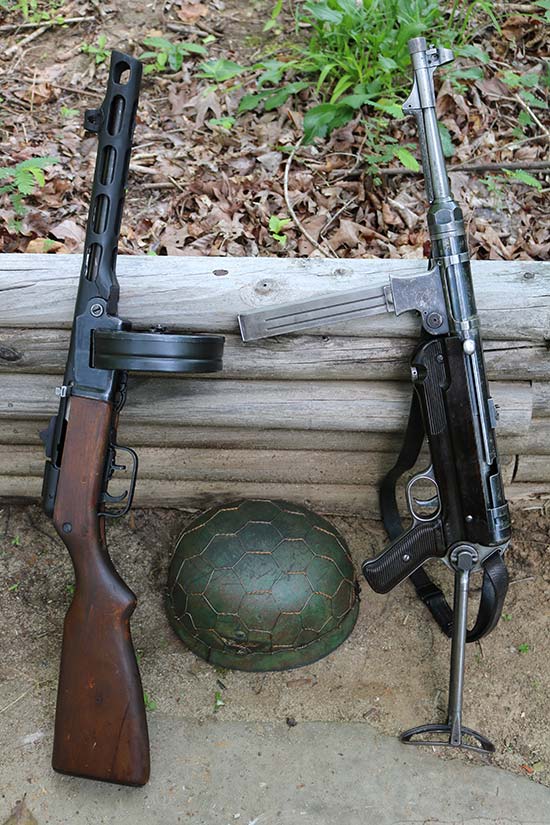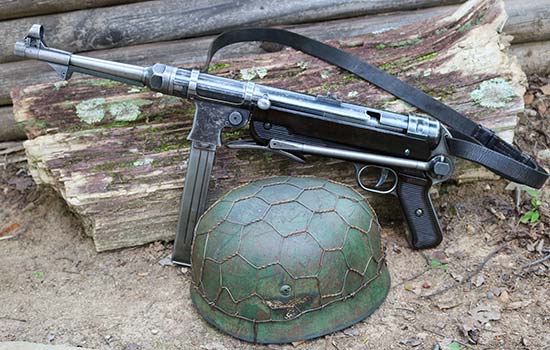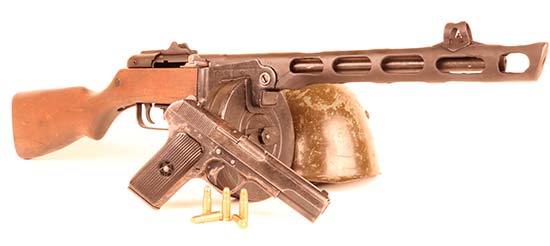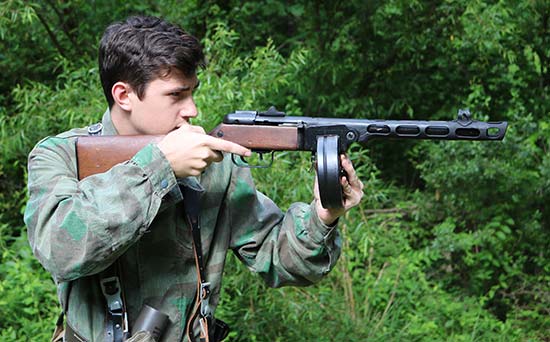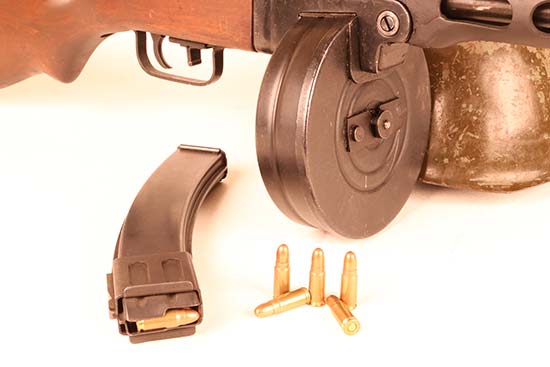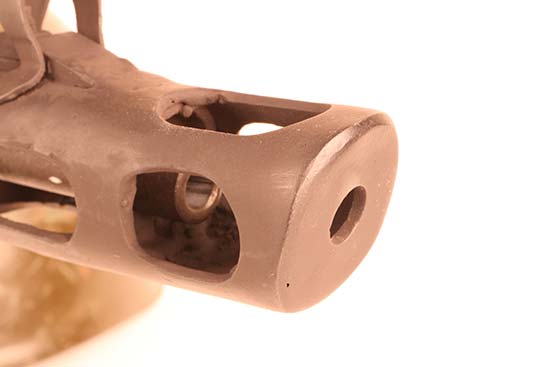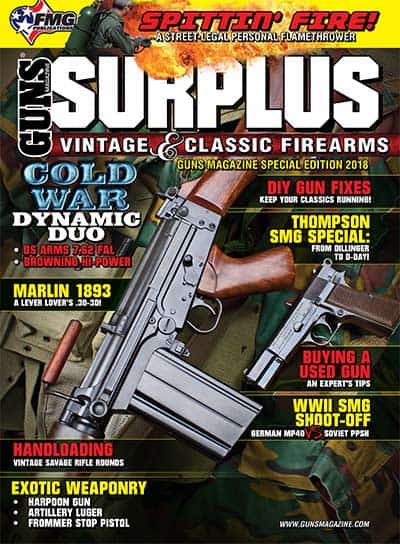Eastern Front Firepower
From The Baltic To The Black Sea. Am German And A
Russian SMG Once Slugged It Out For Supremacy
From September 1, 1939, until September 2, 1945, somewhere between 50 and 80 million people lost their lives. World War II was the bloodiest, most destructive conflict in all of human history.
While the bloodshed on the Western Front was undeniably brutal, it paled in comparison to the carnage in the East. Die Ostfront was the German term. The Russians referred to it as the Great Patriotic War. The combat was utterly pitiless — it was a fight for the supremacy of a way of life. The victors survived. The losers simply died.
On June 22, 1941, the Germans invaded Russia with 3.8 million troops. Operation Barbarossa was the largest offensive in military history. The Russians faced them with some 5.5 million troops of their own. By the end of the war 30 million soldiers and civilians had died in the East. Eighty percent of the military deaths suffered by the German war machine occurred on the Eastern Front.
The desperation of the war in the East was reflected in the weapons each side employed. While volumes have been penned on the various tanks, artillery systems and aircraft used in this theater, one of the most stark comparisons can be made in the two sides’ respective primary submachine guns.
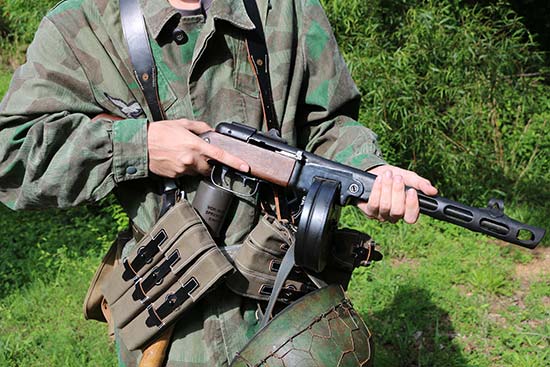
The PPSh was a peasant’s gun built tire-tool tough. Despite rough welds and grungy execution,
when properly tuned it was devastating. The Russians produced six times as many PPSh units as
the Germans manufactured MP40’s. Here, Wyatt is resting his support hand on the shrouded barrel,
but you can bet he won’t do this when firing. Things get mighty warm, mighty fast at 1,000 rpm.
Germany’s MP40
While the German armed forces (and particularly the Waffen SS) employed a wide variety of submachine gun designs, their most common was the MP40. The MP40 was a seminal firearm that changed the way the world made military weapons. From its stamped construction to its 9mm Parabellum chambering to its folding steel stock, the MP40 pioneered much of what we see in modern SMG’s today.
The MP40 was itself an evolutionary development of the MP18. The MP18 originally fed from a side-mounted 32-round drum magazine designed for the WWI-era Artillery Luger P08 Langepistole. Introduced in time to see action in the fetid trench warfare characterizing the “War to End All Wars,” the MP18 introduced the world to the handheld, pistol-caliber automatic weapon.
The MP18 eventually lost its wooden stock and became the ultra-rare MP36. In the MP36 we see shadows of the definitive design, replete with its steel underfolding stock, though in this case it was held in place solely via friction. No more than a handful of these odd guns survived the war.
The subsequent MP38 employed a machined steel receiver that was fairly onerous to produce, but the gun could otherwise pass for an MP40 in dim light. The easiest way to distinguish the two weapons at a glance orbits around the receiver and the magazine well. The receiver of the MP38 sports an obvious series of longitudinal lightening grooves, while its mag well incorporates a hole in each side about the size of a dime.
The definitive MP40 was all stamped steel and Bakelite with nary a spot of walnut. Designed by Heinrich Vollmer, the gun had a flip-adjustable rear sight along with a heavily hooded front. The weird Bakelite bar underneath the barrel was designed to keep the muzzle outside a halftrack when fired over the edge of the vehicle’s armor.
The recoil system was a series of pressed steel cups that collapsed into themselves to yield a remarkably smooth firing cycle. This feature — combined with the gun’s sedate 500 rpm cyclic rate — made it unusually controllable. The firing mechanism was full-auto only.
The magazine was the MP40’s Achilles heel. Despite the gun erroneously having been referred to as a “Schmeisser,” Hugo Schmeisser’s only verified involvement with the project was in the design of the gun’s flawed magazine. A double-column box tapering to a single-position feed, the MP40 mag was all but impossible to load without a loading tool and was notoriously susceptible to dirt and fouling. Though it carried 32 rounds, most German Landsers downloaded theirs to 28 for reliability.
Overall, the MP40 was respected and coveted on both sides of the line. The gun was optimized for mass production but still retained the peculiar tendency of the Germans to serialize everything, including the firing pin. The MP40 was typically issued to squad leaders, tankers and specialist troops, but found wider distribution as the war grew larger in scope. The Germans produced just over 1 million copies of the gun before the MP44 assault rifle supplanted it. Since WWII, the MP40 has been encountered in the hands of Viet Cong guerillas as well as irregular forces in both Africa and the Middle East. The Norwegian Territorial Guard retired its last MP40 SMG in 1990.
Russia’s PPSH
The Pistolet-Pulemyot Shpagina literally translates to “Shpagin Machine Pistol” in honor of Georgi Shpagin, the designer of the Soviet PPSh submachine gun. Intended to replace the more complicated PPD in Soviet Infantry formations, the PPSh was typically referred to as the papasha by the Russians who wielded it. The term means “daddy” in their native tongue.
The PPSh was an open-bolt selective-fire weapon that fired a bottlenecked 7.62x25mm cartridge from either a 35-round curved stick or a 71-round drum magazine. Made predominantly of stamped steel atop a conventional wooden stock, the PPSh at times equipped entire battalions of Soviet Infantry. The Russians produced about 6 million of the guns and they ultimately found their way into the hands of irregular combatants engaged in insurgency warfare around the globe.
The PPSh had a flip adjustable rear sight calibrated for 100 and 200 meters. The receiver and barrel jacket were pressed as a single sheet steel unit and incorporated a very effective muzzle brake to help keep the muzzle down during burst fire. The fire selector was a sliding switch located inside the trigger guard. The magazine release lever folded flat against the receiver when not in use.
The PPSh weighed about 12 lbs. with a loaded drum in place, yet the gun pointed naturally. With a rate of fire of around 1,000 rounds per minute the weapon ran through vast quantities of ammunition quickly. The PPSh was typically issued with a pair of drum magazines matched and serialized to each gun. Mixing and matching drums between guns often resulted in stoppages, something frustrating for modern day collectors. The 35-round stick mag is a double column single feed device that will drive you to drink if you try loading it without a tool.
The PPSh had only 87 parts and was easy to maintain. Pressing the receiver latch inward at the rear of the receiver allowed this assembly to pivot open in the manner of an AR-15. The gun included a polymer buffer in the rear to help protect the receiver during cycling. The reciprocating charging handle had a component that would snap into the receiver as a safety of sorts. During production it was found a single Mosin Nagant rifle barrel could be chambered on both ends and cut in half to produce two PPSh barrels. A friend who faced the PPSh in combat in Korea reported its vast firepower in close range engagements was indeed overwhelming. He still carries the scars where one of those zippy little 7.62×25 rounds punched through the meat of his hand.
SMG Shooting Impressions
Each gun has its own unique personality. The MP40 is markedly more controllable given its front-heavy design and the modest recoil impulse of the 9mm Parabellum. Overall, the MP40 is the more comfortable of the two weapons. It shoulders quickly and it’s a fairly easy chore to keep bursts on target at reasonable ranges. The rigid charging handle protruding from the left side of the gun makes magazine changes fast but necessitates the right-sided sling mount, a minor hassle when toting the weapon long distances.
By contrast, the PPSh is a veritable bullet hose. The gun ejects straight up such that it tends to rain hot empty cases down on the shooter’s head. (Ask me how I know this!) With the drum in place there really isn’t a good spot to hold the weapon with your weak hand. Grasping the ventilated barrel jacket is awkward and can still burn your fingers. Cupping the weak hand underneath the stock behind the drum really puts too much of the gun out forward. I have found the easiest way to manage the weapon is to just grab the drum from the side. But what the PPSh lacks in finesse is more than compensated for in brute force.
In the final analysis the details didn’t matter all that much. The Russians and Germans fought like drunken elephants until the war finally ground to a halt above the Hitler’s bunker in Berlin. Both nations expended incalculable treasure and wasted an entire generation just to play out the delusional fantasies of the two megalomaniacs who helmed them. However, embedded within the mechanical details of the German MP40 and the Soviet PPSh we get a remarkable glimpse into the personalities of these two doomed nation-states. The MP40 was elegant and the PPSh brutish.
Both contributed substantively to the bloodbath that was the Eastern Front.
Special thanks to
www.worldwarsupply.com for the cool replica gear used in this article.

